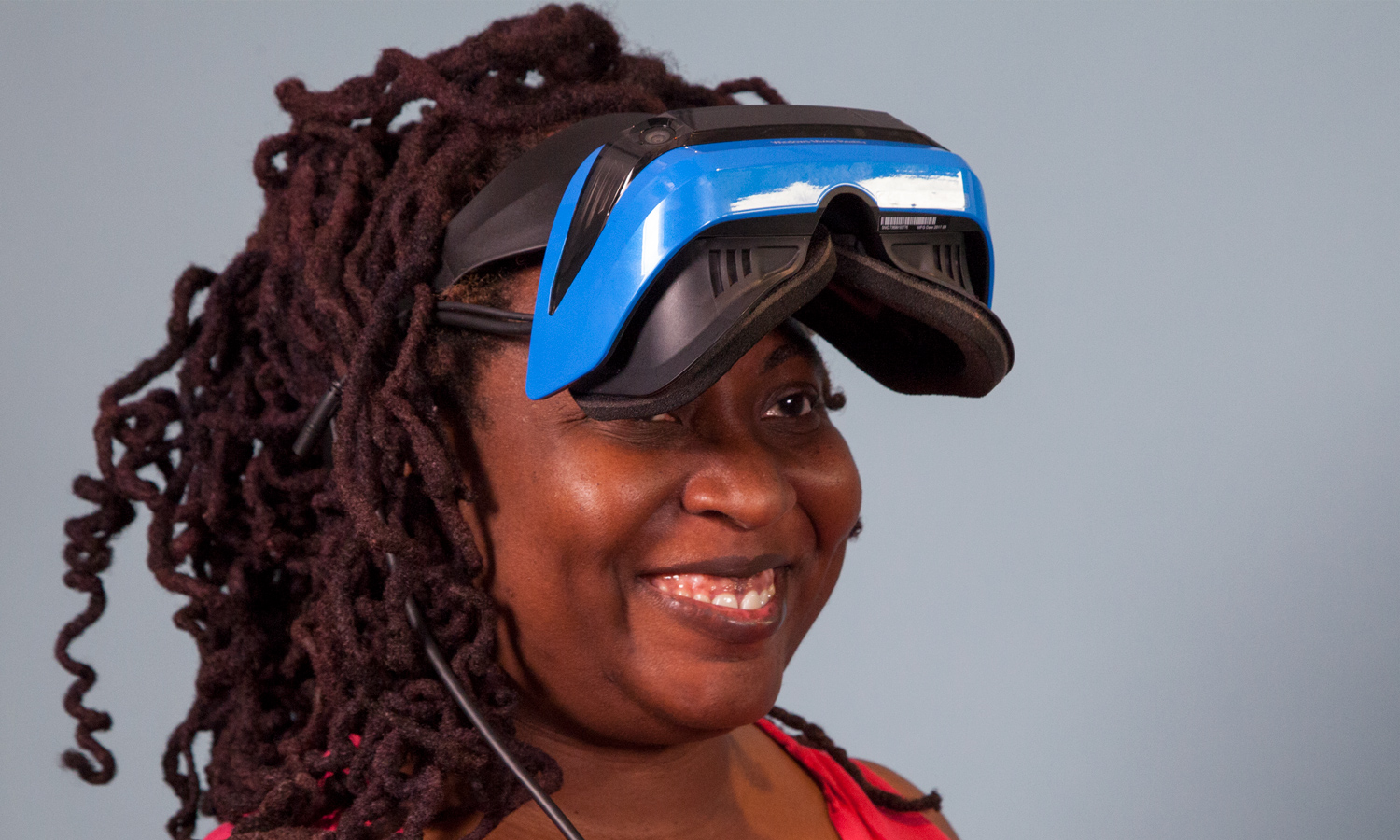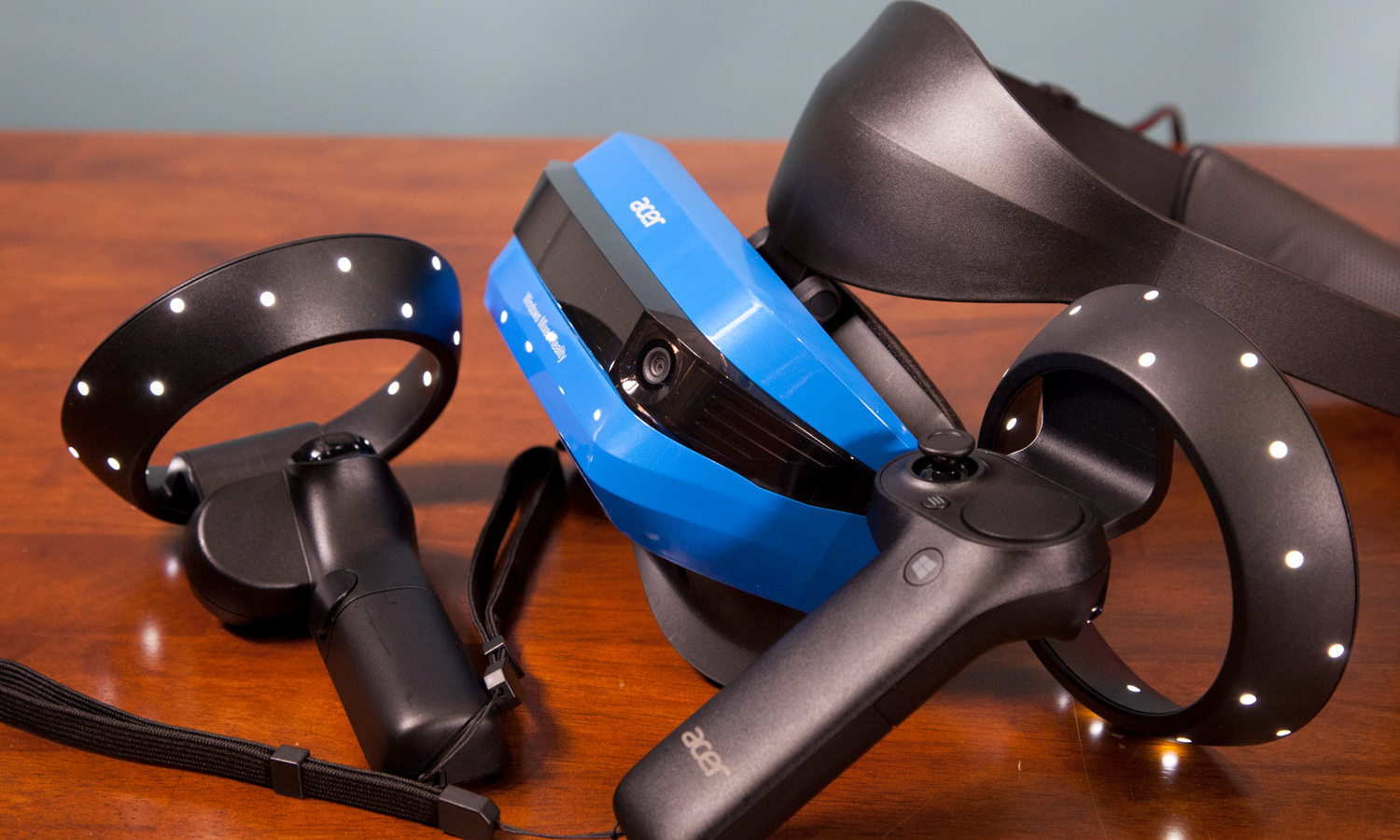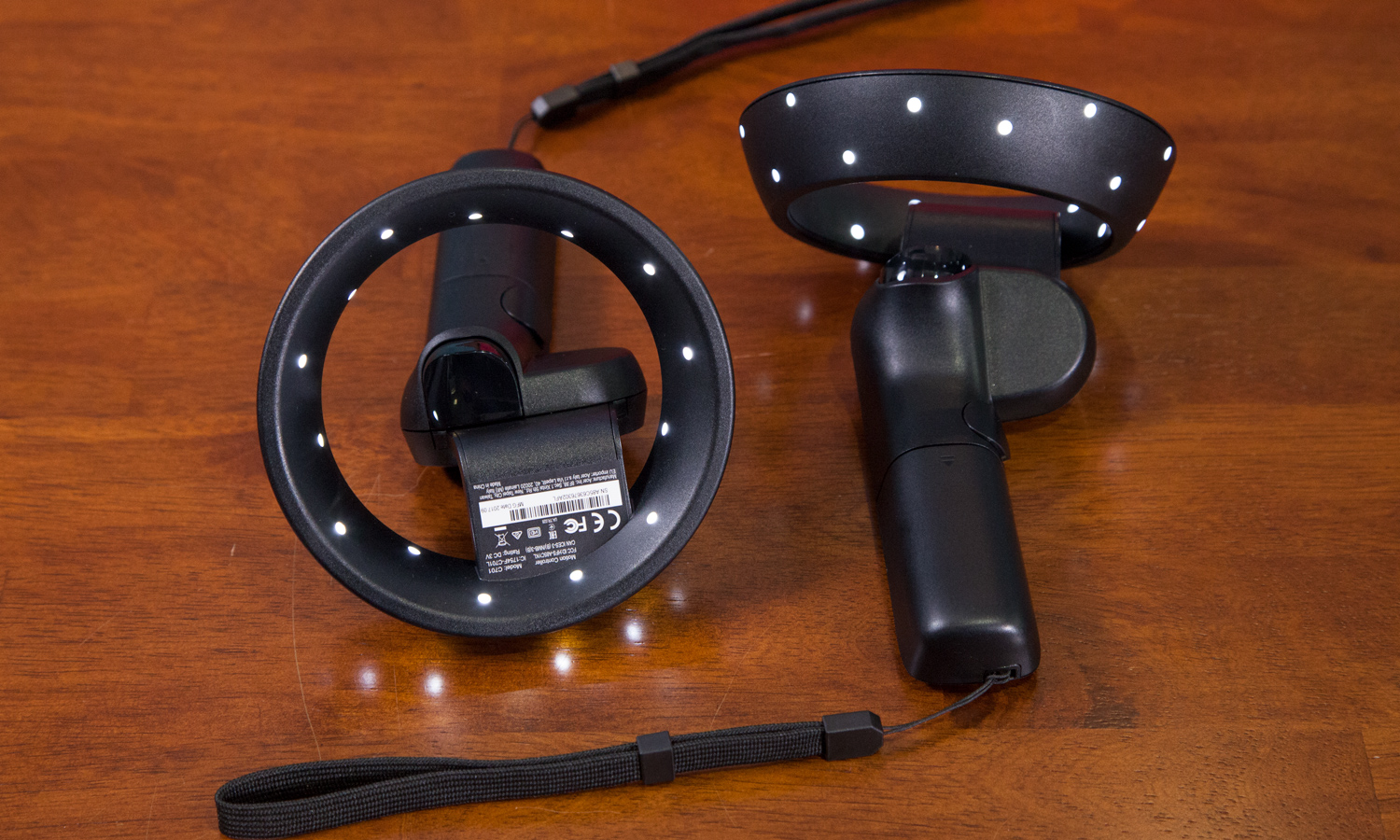Tom's Guide Verdict
The Acer Window Mixed Reality AH101 Headset offers an easy plug-and-play setup and a comfortable design, but it suffers from a small selection of apps, along with some tracking issues.
Pros
- +
Colorful, lightweight design
- +
Compatible with a large number of systems
- +
Doesn't need external sensors
Cons
- -
Apps and games are lacking
- -
Noticeable visual difference depending on the system
- -
Costs the same as the Oculus Rift
Why you can trust Tom's Guide
Just when you were getting used to virtual and augmented reality, here comes Microsoft to muddy up the waters with its new mixed-reality headsets. But hold up, these headsets aren't actually the promised intersection of AR and VR. In fact, as it stands, the $399 Acer Windows Mixed Reality AH101 headset is a lighter, more colorful take on the Oculus Rift and HTC Vive. (In the case of the Vive, it's also a less expensive option.)

Reliant on Microsoft's new Mixed Reality ecosystem, the AH101 is stymied by a lack of apps and spotty tracking. A relatively inexpensive, PC-powered plug-and-play system could be immensely appealing, especially to consumers who have older laptops with integrated graphics kicking about But the AH101 is geared more toward early adopters than mainstream consumers looking to take those first tentative steps into the world of VR.
Design: The bluebird of techiness
My, oh my, how I love colorful tech?

Instead of the demure and frankly boring shades of black, white and gray that most gear is slathered in, the majority of the front of the AH101 is sheathed in a resplendent royal blue. A black strip of plastic sits in the middle, sandwiched by Logos for Acer and Windows Mixed Reality. This middle section of the device houses the pair of tracking cameras. You can find air vents farther back along the face mask at the top and bottom of the device; these help keep you cool during long sessions.
A black hinge connects the actual headset to the headstrap and lets you flip the front part of the device up when you want to briefly check in with the physical world.

With the exception of a royal-blue head buckle set in the center, the adjustable, double-padded headband is made of black-matte plastic. The headset's interior has removable foam padding attached via Velcro and is accentuated by the gleaming lens inset into the headset.

In an attempt to keep things simple and manageable, Acer equipped the AH101 with just two cables: A combination audio jack and a 13-foot cord with a USB 3.0 and HDMI 1.4/2.0 input are sequestered on the right side of the headset. A slim, black plastic band keeps the cables are in place.
Measuring 7.3 x 1.4 ~ 4.7 x 1-inches and weighing a mere 6 ounces, the AH101 is much smaller and lighter than both the Oculus Rift (8.5 x 6.7 x 5 x 4 inches, 16.8 ounces) and HTC Vive (7.4 x 5 x 3.5 ~ 5 inches, 19.8 ounces).
Comfort
I'm a fan of the AH101 if for no other reason than that it's not a battle to get my butt-length hair into the headset. Because there's' no top strap, all I have to do is pull my hair through the wide opening, and I'm done. With the Rift or Vive, I must resort to strategic maneuvering based on my hairstyle.

Because the AH101 is so light, I wore it for more than an hour with no ill effects. The adjustable headband has thick, plush, sweat-proof padding that wrapped my head in what's tantamount to a soft hug. That moisture resistance does come in handy, as I noticed that the front of the headset can get a bit warm after long periods of use. Similar to the PlayStation VR, the AH101 has a large, rear-mounted knob that's used to adjust the overall fit of the band — just remember righty-tighty, lefty-loosey, and you should be good to go.
However, my favorite thing about the headset is the flip-up visor. It's a seemingly insignificant feature until you need to find something in the real world without having to go through the hassle of removing the device. Thanks to the large hinge, the front portion of the AH101 lifts up with a satisfying snap and sits securely in place until I pull it back down.
Specs
The AH101 is outfitted with a 2.9 x 2-inch LCD panel that provides 1440 x 1440 resolution for each eye and a 100-degree field of view. The Vive and the Rift (3.4 x 2-inch panel) each have a 2160 x 1200 OLED display, which works out to 1080 x 1200 per eye with a wider, 110-degree FOV. The PS VR's 5.7-inch RGB OLED screen delivers 1080 x 960 with a 100-degree FOV.

As far as refresh rates (the number of frames per second the screen will display, with higher rates ensuring a smoother experience), the AH101 can deliver 90 Hertz when plugged into a system with discrete graphics and an HDMI 2.0 port. The refresh rate drops to 60Hz on a system with integrated graphics and an HDMI 1.4 port. While 60Hz will give you a passable VR experience in most cases, it's not as smooth. The Rift and Vive are locked in at 90Hz, while the PSVR hits 90Hz for VR games and apps and 120Hz for non-VR content, like movies.
Unlike most of its competitors, the AH101 doesn't need a host of wall-mounted sensors to make the virtual magic happen. Instead, the headset uses the two fish-eye sensors on the front of the device for inside-out tracking, and this lets you walk around sans external sensors. Similar to the Rift, Vive and other MR systems, the headset has an integrated gyroscope, accelerometer and magnetometer for 6-degrees-of-freedom positional tracking. That means the system will keep up with your head movements accurately, at least in theory.
Setup
For the most part, the AH101 is a plug-and-play setup. After plugging in the HDMI and USB 3.0 connectors to the Acer Predator Triton 700, I received a prompt informing me that I had to update the system to the latest Windows Fall Creators Update. Once everything was installed, it was time to actually set the thing up. It's a relatively painless 5- to 7-minute process, featuring a series of easy-to-follow, step-by-step screens. It starts with a quick check of your computer's specs to ensure that the machine is compatible.
From there, it's time to set up the controllers. After you turn them on, you have to remove the battery covers in order to access the pairing button, which is a bit of a hassle. But since you don't want to accidently unpair the controllers while you're playing, that's ultimately a prudent location choice.
Once everything is paired up, you're given a choice between a seated- or a standing-room-scale experience. If you choose the room-scale setup, you'll be instructed to grab the headset and click the Center button on the laptop. Next, you click the Trace button, as you use the headset to trace the confines of your play area. From there, you're ready to jump into Microsoft's version of virtual reality. And it's not too shabby.
Compatibility
To get the best results out of your headset (i.e., running at 90Hz), your laptop or desktop will need to hit some minimum specs. You'll need the Windows 10 Fall Creators Update, at least 16GB of RAM, an Nvidia GTX Geforce 965M or AMD Radeon RX 460 GPU, an HDMI 2.0 or a DisplayPort 1.2, and a USB 3.0 port. Desktop owners will need to have at least a 6th-Generation Intel Core i5 processor, while the minimum entry for laptop owners is a 7th-Gen Intel Core i5 processor with Hyper-Threading. The AH101 will run on systems with integrated graphics and an HDMI 1.4 port, like the Asus VivoBook Flip 14, but just at a lower 60Hz.
Controllers
Acer ships the AH101 with what looks like a pair of funky, portable disco balls. However, aspects of the design, particularly the large circular ring on the top of each peripheral, call to mind the more demure look and feel of the Oculus Touch controllers. Subtlety is not the name of the game here, though. These controllers' rings are dotted with white, glowing LEDs that the fish-eye sensors on the headset track to keep up with your hand movements.

The actual part of the controller that you hold in your hand is pretty comfortable. The oblong portion is just the right size to allow you to grip and press all the buttons without inducing a hand cramp. Speaking of buttons, on the top portion of each controller, you’ll find a clickable touchpad that has a variety of uses depending on the game or app. There's also an analog stick and a Menu button. The Windows button sits directly below the Menu button and transports you back to the hub world. Depending on which controller you're holding, the Grab trigger sits directly under your thumb while the trigger resides just beneath your index finger.

During my time with the controllers, I had no problems using one of the touchpads to teleport to my desired location and clicking a trigger to cue up a game of Superhot VR or Ghostbusters. And when it was time to grab a gun or shuriken, the strong but gentle pressure I exerted on the Grab button made me feel like I was really gripping the object I was gazing at in the game.
Interface
Every VR headset has a home base, and the AH101 is no different. When you put on a Microsoft MR headset, the hub world is located at the Cliff House, a rather abstract piece of architecture with white walls and furniture that you can reposition at will. The view of Mount Rainier is rather stunning juxtaposed against the bright blue sky, dark blue ocean and bone-white walls.
Along several of the walls, you'll find virtual windows for a number of Microsoft apps, including Edge, Store, Hologram and Skype. Using the controllers, you can resize the windows or snap them into a new location with a simple point and a click. Pressing the Windows button on either controller will queue up a small Start Menu that mimics the tiles you'd find when perusing a Windows PC.
Images on the AH101 are clear but not as pristine or sharp as what you'd find on the competition.
I was pleasantly surprised to see that Microsoft's virtual keyboard, which I find a bit unwieldy in other mediums, was so useful in VR. It came in especially handy when I had to enter my password for two-factor authentication. It's not a replacement for an actual keyboard, because you need to point and click at each letter, but it's fine for shooting off a short email or note.
Visual Experience
Even though the AH101 has higher-resolution lenses than both the Vive and the Rift, I discovered that images on the AH101 are clear, but not as pristine or sharp as what you'd find on the competition. That's true with the exception of the PlayStation VR and mobile VR headsets like the Samsung Gear VR and the Google Daydream View. For example, the lines in Fantastic Contraption lacked definition on the the AH101 compared to how they looked on the Vive and Oculus.
I definitely noticed the blur if I turned my head a bit too fast. Also, despite tracing a fairly large space, I found that the boundaries the headset established for me were often smaller than what I traced. My other gripe is the lackadaisical tracking of the motion controls. When all the moons were aligned, the AH101 did a solid job of keeping pace with my frantic hand movements. However, there were plenty of times when a limb just disappeared on me. This happened several times when I was playing Superhot VR, which left me clawing for that lifesaving gun or ashtray while struggling to dodge the incoming volley of attacks.
There's also a distinct difference between playing with a 90Hz and a 60Hz refresh rate. On Superhot VR and Space Pirate Trainer at 90Hz, the Acer Predator Triton 700 delivered smoother movement and tracking with clearer images. When I switched over to the VivoBook Flip 14 and its integrated graphics chip, there was some stuttering and noticeably muddier images. The 60Hz viewing experience is better when you're watching a 360 movie in Jaunt VR, but not much.
Say Hello to Cortana
One feature that Microsoft's headsets have over the competition is the use of voice commands. You can summon the company's digital assistant, Cortana, to perform a number of tasks, such as selecting objects in the VR space, resizing browsers and objects, and launching apps. You can also do the regular Cortana stuff, like asking for restaurant recommendations or about the current weather. Cortana worked well enough on the mundane tasks, but sometimes, it had trouble understanding my commands even when I tried several pairs of headphones.
Overall, Cortana support is a nice feature to have, but I'm not sure that I would use it that much, because I have a pair of controllers in my hands that work much faster. Also, it'd be nice if Microsoft would add a physical representation of Cortana to Cliff World, because in the Halo series, she's a virtual artificial intelligence.
But Is It Mixed?
Microsoft has labeled the AH101 and the company's other upcoming headsets as MR or mixed-reality devices. But are they really? The short answer is no.
As it pertains to the AH101, the Mixed Reality moniker is for marketing purposes only.
Although the AH101 has a pair of sensors on the front, these are tasked with keeping tabs on your head position and controllers, not for layering digital media onto the real world. At their core, Microsoft's headsets are simply a step on the road to tetherless PC-powered VR.
As it pertains to these devices, the MR moniker is for marketing purposes only. If you want real MR, you'll have to wait for consumer versions of HoloLens or Meta 2 to come to market.
Games and Apps
As the new kid on the VR block, Microsoft is starting off at a serious disadvantage in terms of content. To date, the Windows Store features 49 games and apps, many of which (including Arizona Sunshine, Superhot VR and Dreadhalls) are already available in both the Oculus and Steam stores.
To make up for the lack of content, the Windows Store offers quite a few 360-degree video-curation apps, like JauntVR, vTime and LittleStar. You can also get Hulu, in case you want to watch the upcoming show Runaways in a virtual theater.
To date, the Oculus store boasts more than 2,000 apps and games, while the Vive and PS VR have more than 300 and 100 pieces of content, respectively. Microsoft is hoping to counteract its dearth of content by tapping into the Steam Store.
Bottom Line
The Acer WMR AH101 and all the upcoming Microsoft headsets are the mixed-reality devices that weren't. Despite a pair of sensors that could potentially be used to overlay digital images onto the physical world, there's not much mixed about Microsoft's current version of reality. Instead, consumers get a headset that can deliver solid virtual reality with a few Microsoft productivity features for good measure.

Acer sells the AH101 for $399, which matches the price of the Oculus Rift but is significantly cheaper than the $599 HTC Vive's cost; a PlayStation VR bundle, which comes with two motion controllers and PS camera, costs $499 (a stand-alone headset costs $299). In the case of the AH101, you get a headset that's significantly lighter and easier to set up than competing systems are. There's also the added bonus of being able to use the headset with less powerful laptops
However, the visual and tracking quality isn't on a par with that of the more advanced technology found in the Rift and Vive. You're also confined to Microsoft's extremely limited app library until the anticipated Steam VR compatibility comes into play. That means outside of the plug-and-play convenience and integrated graphics compatibility, you're basically paying for a lower-tier product. It's nice that consumers can use the headset with a $300 laptop, but VR, MR and AR should be experienced at the highest quality possible.
Overall, the AH101 is a solid choice for consumers who own lower-tier laptops and lack the space to accommodate either the Vive or the Rift or who just want a portable plug-and-play VR system. For everyone else, I'd say save your pennies and go for the higher-tier system.
\
Credit: Tom's Guide/Shaun Lucas
Sherri L. Smith has been cranking out product reviews for Laptopmag.com since 2011. In that time, she's reviewed more than her share of laptops, tablets, smartphones and everything in between. The resident gamer and audio junkie, Sherri was previously a managing editor for Black Web 2.0 and contributed to BET.Com and Popgadget.

